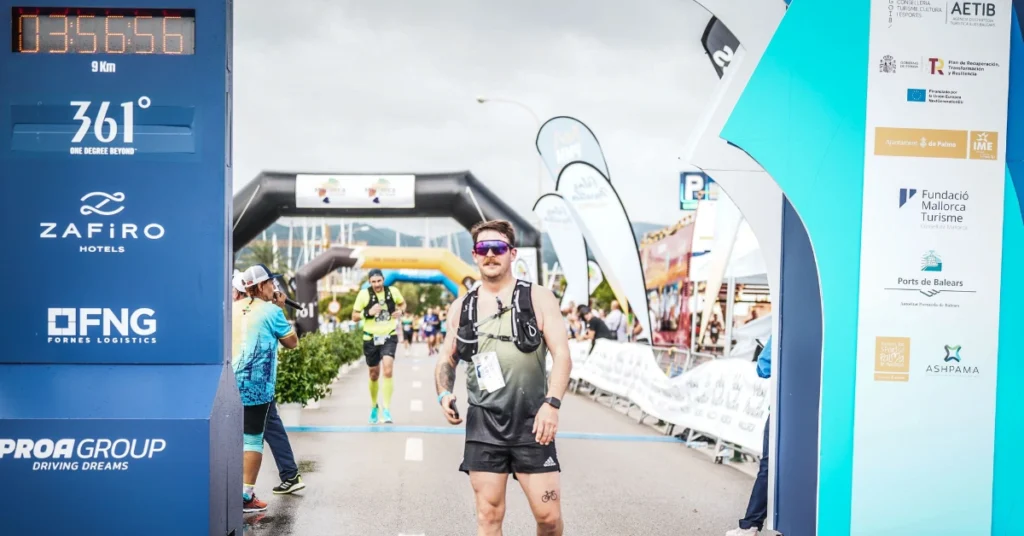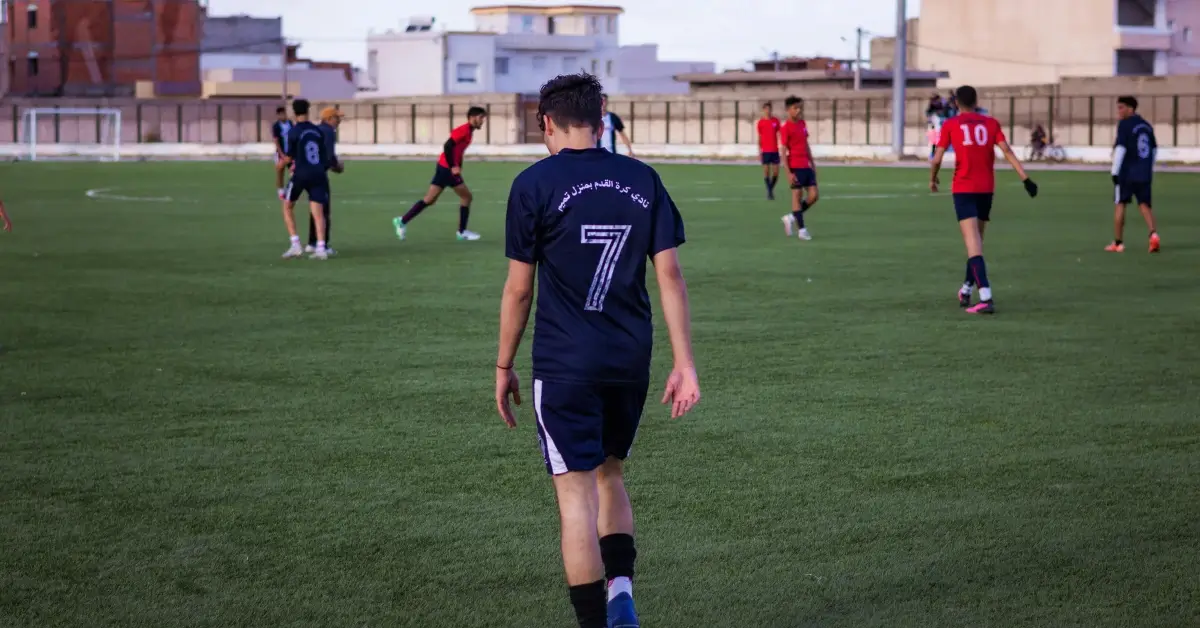Soccer is a beloved sport played worldwide, and the players’ stamina and endurance are truly fascinating. As avid soccer fans, we often marvel at the impressive amount of running players do on the field. So, how many miles does a soccer player run in a game?
It turns out that, on average, soccer players run about 5 miles in a game. However, the distance covered depends on their position on the field. For instance, goalkeepers run the least, while midfield players usually run the most as they need to cover the entire field. In some cases, a soccer player can run as much as 8.5 miles in a single game.
Pro´s:
- ✅ Reversible
- ✅ Dri-FIT
- ✅ Breathable
Con:
- ❌ Attention: Pack only contains one sweatband.
Overview of Running in Soccer
⚽ Importance of Running for Soccer Players
Running is a crucial part of soccer as it directly impacts the game’s pace, stamina, and overall performance. Our ability to cover more ground and maintain a high level of energy throughout a match gives us a competitive edge.
In soccer, players need to perform a variety of movements like sprinting, jogging, and sudden change of pace. These movements demand an exceptional level of cardio fitness and muscular endurance. Proper running techniques enable soccer players to reach their full potential on the field and contribute to the team’s success.
⚽ Average Distance Covered by Soccer Players
The average distance each player covers during a soccer match varies depending on their position on the field. In general, soccer players run an average of 7 miles (11.26 kilometers) in a single game.
So, how many miles does a soccer player run in a game?
Here’s a simple breakdown of the average distance covered by various positions in a game:
- Goalkeepers: The least running (approximately 1-2 miles)
- Defenders: Moderate running (4-6 miles)
- Midfielders: Most running (6-8 miles)
- Forwards: Moderate running (5-7 miles)
This demonstrates the importance of tailored training routines for players in different positions, ensuring their fitness levels match the demands of their role on the field.
Positional Analysis of Distance Covered

In this section, we’ll delve into the various positions on the soccer field and analyze the amount of running done by players in each position.
⚽ Midfielders: The Heart of Running
- Midfielders cover the most ground in a soccer game, typically running between 6 to 8 miles.
- The workload of midfielders varies based on their specific roles, with central midfielders focusing on orchestrating play and covering more ground, and wide midfielders making intense sprints down the wings.
⚽ Defenders and Central Defenders
- Central defenders typically cover around 5 to 6 miles in a game, focusing on protecting the goal and covering less ground than midfielders.
- Fullbacks, on the other hand, need to support the attack and track back to defend, covering similar distances as midfielders due to their dynamic role on the pitch.
⚽ Strikers and Wingers
- Wingers, depending on their defensive responsibilities, may cover more ground, estimated to run 5 to 7 miles during a game.
- Strikers, particularly lone forwards, may cover less distance as they conserve energy for critical moments, influenced by the team’s playing style and possession of the ball.
⚽ Goalkeepers: A Different Kind of Distance
- Goalkeepers cover around 2 miles during a game, focusing on organizing the defense and reacting to threats on goal within their penalty area.
- Their tasks are energy-intensive, requiring quick reflexes, strength, and agility to prevent goals.
Factors Influencing Running Distance

🏃 Age and Physical Condition
- Younger and physically fit soccer players generally cover more distance than older and less fit counterparts due to increased stamina, speed, and endurance.
- Proper training and conditioning are crucial for all players to maintain optimum fitness levels and perform at their best on the field.
⚽ Game Tactics and Formation
- Different game tactics employed by coaches significantly impact the distance a player covers in a match, with the chosen formation dictating specific roles and positional responsibilities.
- Midfielders cover the largest distances due to their constant movement and support for both offensive and defensive play, while goalkeepers and defenders generally cover less distance due to their fixed positions.
Positions in a standard formation:
- Forwards: Attacking players who focus on scoring and creating goal opportunities.
- Midfielders: Pivot between offense and defense, supporting both sides of the field.
- Defenders: Safeguard their goal from the opposition’s attack.
- Goalkeeper: Guards the goal and prevents the opposing team from scoring.
🌦️ Environmental Conditions
- Environmental conditions during a game, such as rain, wind, and temperature, can significantly impact the distance soccer players run, affecting stamina and ability to cover long distances.
- Playing in heavy rain can make it challenging to maintain footing and run as much as in dry conditions, while hot and humid environments can lead to dehydration and fatigue, limiting a player’s capacity to cover significant distances.
Comparison to Other Sports

⚽ Soccer vs American Football
When comparing soccer to American Football (NFL), there is a significant difference in the distance covered by players during a game. Soccer players, on average, run about 5 miles in a game. In contrast, NFL players cover far less distance, as the gameplay in American Football includes more breaks and shorter bursts of action. As a result, NFL players typically run less than 2 miles per game.
🏈 Soccer vs Other Popular Sports
In this section, we’ll compare soccer with other popular sports like basketball, baseball, and tennis:
- 🏀 Basketball: Basketball players, known for their fast-paced movements and quick changes in direction, cover an average distance of 2-3 miles per game. Although basketball is a high-intensity sport, the total distance run is still less than that of soccer players.
- ⚾ Baseball: Compared to soccer, baseball involves relatively less running. Baseball players mostly run short distances at high speeds while fielding or running between bases. On average, they cover far less distance than soccer players in a game.
- 🎾 Tennis: Tennis players run, on average, 3 miles per game. Tennis matches can vary widely in terms of time and effort required, depending on the skill level and intensity of the players. In terms of distance covered, it falls between soccer and basketball.
Physical and Technical Demands
🏃 Stamina and Endurance Requirements
- On average, professional soccer players run approximately 7 miles (11.26 kilometers) during a game, highlighting the sport’s demanding nature and the need for exceptional endurance levels.
- The physical demands on soccer players can vary based on factors such as position, playing style, and match intensity, with midfielders covering the most ground due to their role in connecting defensive and offensive actions.
- Energetic midfielders might cover up to 6 miles (9,700 m) during a game, while defenders and forwards tend to run slightly less.
- Endurance is crucial for soccer players to recover quickly from short bursts of sprinting or high-intensity runs, enabling them to maintain a solid performance throughout the entire game, even during the final minutes when fatigue sets in.
⚡ Acceleration, Speed, and Sprinting
- Acceleration and speed are crucial attributes for soccer players, particularly forwards and wingers, enabling them to get past defenders and create scoring opportunities by quickly shifting from a jog to a full sprint.
- Approximately 10% of a soccer player’s total running distance in a game is covered at high intensity, emphasizing the importance of the ability to explode into action, reach top speed quickly, and maintain sprints for short distances.
- Defenders also rely on speed to catch up to opposing forwards and prevent scoring opportunities, highlighting the significance of swift changes in direction and sudden stops for all field players competing at a high level.
Data and Technology in Soccer

😊 Use of GPS Trackers and Technology
In recent years, the use of GPS trackers and other tracking technology has revolutionized the way we analyze and understand soccer players’ performance. With wearable devices, we can gather real-time data on a player’s movements, heart rate, and other key performance indicators. This information is invaluable in assessing individual players’ skills, as well as overall team performance.
For example, with GPS trackers, we can monitor players’ speed, distance covered, and positions on the field. This allows coaches to see how well their team is executing strategies and make adjustments if needed. Additionally, it can help in preventing injuries by identifying potential areas of concern in a player’s physical health.
😄 Monitoring Running Performance
Running performance is a fundamental aspect of soccer, and we can now analyze it in greater detail using the data collected through tracking technology.
- Elite soccer players cover 6-9 miles (9-14 km) per game.
- Majority of the distance covered is low to medium intensity, with only 10% being high-intensity.
Player Substitutions and Playing Time
🏃♂️ Impact of Substitutions on Running Distance
Many leagues now allow up to five substitutions per team during a game, which can bring fresh legs onto the field and likely reduce the distance covered by some individual players.
- Different positions cover varying distances, with midfielders typically running the most distance as they cover the entire field, while goalkeepers run the least, covering around 2 miles per game.
- Strategic player substitutions allow coaches to manage players’ overall fatigue levels, ensuring they perform at their best throughout the match.
⏱️ Playing Time and Its Effect on Players
Playing time significantly influences the distance covered by soccer players in a game, as substitutions and player rotations impact the amount of time each player spends on the field.
- A player’s running distance is affected by the duration of time spent on the field, with substitutions leading to varying distances covered by different players.
- Soccer coaches utilize player rotations and substitutions to manage players’ workload, especially during periods of multiple matches, aiming to distribute physical demands across the team and maintain an optimum energy level for each player.
International Soccer Insights

In this section, we’ll dive into some insights about the distance soccer players run in various competitions, including international and league-based tournaments. We’ll focus on an analysis of Premier League players and a comparison of distances run in different soccer tournaments and leagues.
😀 Analysis of Premier League Players
The Premier League, known as the English Premier League (EPL), is one of the top soccer leagues in the world. Players in this intense competition are known for their outstanding physical abilities. A study revealed that soccer players in the EPL cover an average of 7 miles per game.
So, how many miles does a soccer player run in a game?
Here’s a breakdown of the average miles run by position in the EPL:
- Midfielders: 7-9 miles
- Full-backs: 6.5-7.5 miles
- Wingers: 6.3 miles
- Forwards: 5.5-6.5 miles
- Centre-backs: 5-6 miles
- Goalkeepers: 1-2 miles
😊 Soccer Tournaments and Leagues Comparison
Now, let’s take a look at how the distance covered by soccer players varies in different competitions, including the World Cup and the Champions League.
- World Cup: In the world’s most prestigious soccer tournament, players are known to run an estimated 7 miles per game. The competition’s intensity and high stakes often result in players pushing themselves to the limit.
- Champions League: This elite club competition also sees players giving their all on the field. The distance per game depends on the stage of the tournament and the player’s role, but overall, it’s quite similar to the average miles during the World Cup and Premier League matches.
Our Opinion on How Many Miles Does a Soccer Player Run in a Game
In our opinion, soccer players run an average of 5 miles during a game. However, this number can vary depending on various factors, such as player’s position, style of play, and the level of competition. Some sources suggest that professional soccer players can run anywhere between 7 and 10 miles in a given game.


Here’s a rough breakdown of the miles soccer players run by position:
| Position | Miles Covered |
|---|---|
| Midfielders | 6 to 7.5 |
| Strikers | 4.5 to 6 |
| Defenders | 5 to 6.5 |
| Goalkeepers | 1 to 2 |
Of course, these are just general estimates, and individual players may cover more or less distance during a game. The distances can also vary depending on the team’s tactics. For example, a team that relies heavily on possession and attacking football may require players to cover more ground than a team that focuses on counterattacking and sitting back in defense.
FAQ
How many km does Kante run in a game?
N’Golo Kanté is known for his exceptional work rate and high distance covered in games. He has been reported to cover around 11 kilometers (approximately 6.8 miles) during a single game, showcasing his remarkable stamina and endurance on the field.
How many km does Messi run in a game?
Lionel Messi has been noted to run an average of approximately 7-8 kilometers (around 4.3-5 miles) during a game. This showcases his ability to cover considerable ground despite his role as an attacking player.
Is Ronaldo the fittest footballer?
According to various sources, including Men’s Health and Sports Illustrated, Cristiano Ronaldo has been recognized as one of the fittest footballers. He is known for his exceptional physical conditioning, which has contributed to his enduring success in the sport.
What is your option on “how many miles does a soccer player run in a game”? I would love to hear it in the comments. I’m sure you also like reading about how long to wait after eating to run or post run feeling.



